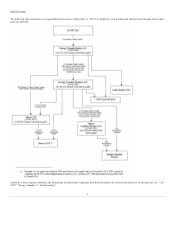Energy Transfer 2015 Annual Report Download - page 18
Download and view the complete annual report
Please find page 18 of the 2015 Energy Transfer annual report below. You can navigate through the pages in the report by either clicking on the pages listed below, or by using the keyword search tool below to find specific information within the annual report.
Table of Contents
Midstream
The following details our assets in the midstream segment.
Southeast Texas System
• Approximately 7,100 miles of natural gas pipeline
• One natural gas processing plant (La Grange) with aggregate capacity of 210 MMcf/d
• 10 natural gas treating facilities with aggregate capacity of 1.2 Bcf/d
• One natural gas conditioning facility with aggregate capacity of 200 MMcf/d
The Southeast Texas System is an integrated system that gathers, compresses, treats, processes and transports natural gas from the Austin Chalk trend. The
Southeast Texas System is a large natural gas gathering system covering thirteen counties between Austin and Houston. This system is connected to the Katy
Hub through the East Texas pipeline and is connected to the Oasis pipeline, as well as two power plants. This allows us to bypass our processing plants and
treating facilities when processing margins are unfavorable by blending untreated natural gas from the Southeast Texas System with natural gas on the Oasis
pipeline while continuing to meet pipeline quality specifications.
The La Grange processing plant is a natural gas processing plant that processes the rich natural gas that flows through our system to produce residue gas and
NGLs. Residue gas is delivered into our intrastate pipelines and NGLs are delivered into our NGL pipelines and then to Lone Star.
Our treating facilities remove carbon dioxide and hydrogen sulfide from natural gas gathered into our system before the natural gas is introduced to
transportation pipelines to ensure that the gas meets pipeline quality specifications. In addition, our conditioning facilities remove heavy hydrocarbons from
the gas gathered into our systems so the gas can be redelivered and meet downstream pipeline hydrocarbon dew point specifications.
North Texas System
• Approximately 160 miles of natural gas pipeline
• One natural gas processing plant (the Godley plant) with aggregate capacity of 700 MMcf/d
• One natural gas conditioning facility with capacity of 100 MMcf/d
The North Texas System is an integrated system located in four counties in North Texas that gathers, compresses, treats, processes and transports natural gas
from the Barnett and Woodford Shales. The system includes our Godley processing plant, which processes rich natural gas produced from the Barnett Shale
and is integrated with the North Texas System and the ET Fuel System. The facility consists of a processing plant and a conditioning facility.
Northern Louisiana
• Approximately 280 miles of natural gas pipeline
• Three natural gas treating facilities with aggregate capacity of 385 MMcf/d
Our Northern Louisiana assets comprise several gathering systems in the Haynesville Shale with access to multiple markets through interconnects with
several pipelines, including our Tiger pipeline. Our Northern Louisiana assets include the Bistineau, Creedence, and Tristate Systems.
Eagle Ford System
• Approximately 1,090 miles of natural gas pipeline
• Four processing plants (Chisholm, Kenedy, Jackson and King Ranch) with capacity of 1,940 MMcf/d
• One natural gas treating facility with capacity of 300 MMcf/d
The Eagle Ford gathering system consists of 30-inch and 42-inch natural gas transportation pipelines delivering 1.4 Bcf/d of capacity originating in Dimmitt
County, Texas and extending to our Chisholm pipeline for ultimate deliveries to our existing processing plants. Our Chisholm, Kenedy and Jackson
processing plants are connected to our intrastate transportation pipeline systems for deliveries of residue gas and are also connected with our NGL pipelines
for delivery of NGLs to Lone Star.
12
























